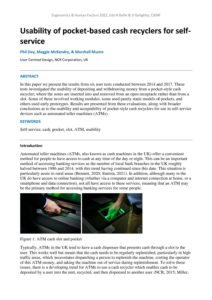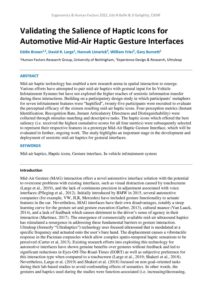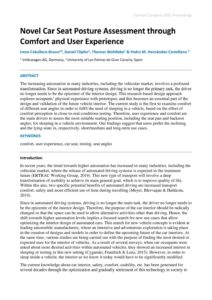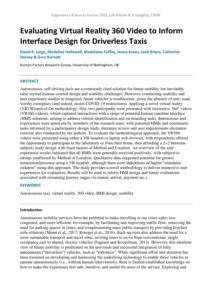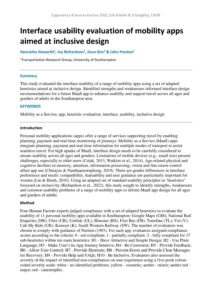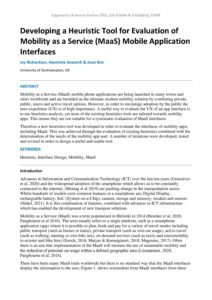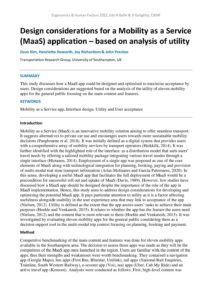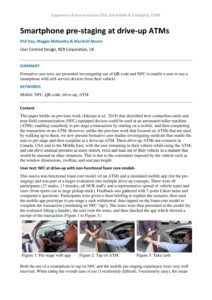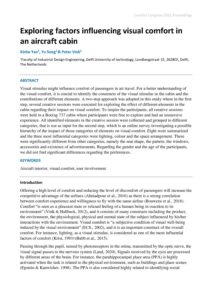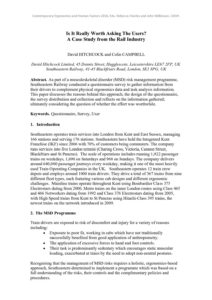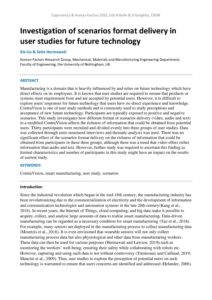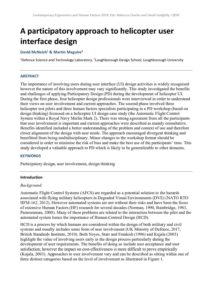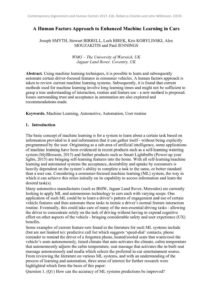User experience
Lessons in the Metaverse: Teaching University students about Virtual Reality from within Virtual Reality
| Document | Author Gary Burnett & Catherine Harvey |
| Abstract There is considerable potential in the education sector for the use of immersive virtual worlds to enhance student learning and engagement. This paper outlines five key recommendations for teaching University students in future ‘Metaverse’ contexts. These guidelines are based on video/survey data collected from 266 students during a module that has run predominately in virtual reality for the last three years, as well as the reflective experiences of the teachers. |
Usability of pocket-based cash recyclers for self-service
| Document | Author Phil Day, Maggie McKendry & Marshall Munro |
| Abstract In this paper we present the results from six user tests conducted between 2014 and 2017. These tests investigated the usability of depositing and withdrawing money from a pocket-style cash recycler; where the notes are inserted into and removed from an open receptacle rather than from a slot. Some of these involved working modules, some used purely static models of pockets, and others used early prototypes. Results are presented from these evaluations, along with broader conclusions as to the usability and acceptability of pocket-style cash recyclers for use in self-service devices such as automated teller machines (ATMs). |
Validating the Salience of Haptic Icons for Automotive Mid-Air Haptic Gesture Interfaces
| Document | Author Eddie Brown, David R. Large, Hannah Limerick, William Frier & Gary Burnett |
| Abstract Mid-air haptic technology has enabled a new research arena in spatial interaction to emerge. Various efforts have attempted to pair mid-air haptics with gestural input for In-Vehicle Infotainment Systems but have not explored the higher reaches of semiotic information transfer during these interactions. Building on a participatory design study in which participants’ metaphors for seven infotainment features were “haptified”, twenty-five participants were recruited to evaluate the perceptual efficacy of the sixteen resulting mid-air haptic icons. Four perception metrics (Instant Identification, Recognition Rate, Instant Articulatory Directness and Distinguishability) were collected through stimulus matching and descriptive tasks. The haptic icons which offered the best saliency (i.e. received the highest cumulative scores for all four metrics) were subsequently selected to represent their respective features in a prototype Mid-Air Haptic Gesture Interface, which will be evaluated in further, ongoing work. The study highlights an important stage in the development and deployment of semiotic mid-air haptics for gestural interfaces. |
Novel Car Seat Posture Assessment through Comfort and User Experience
Evaluating Virtual Reality 360 Video to Inform Interface Design for Driverless Taxis
| Document | Author David R. Large, Madeline Hallewell, Madelaine Coffey, Jenna Evans, Leah Briars, Catherine Harvey & Gary Burnett |
| Abstract Autonomous, self-driving taxis are a commonly cited solution for future mobility but inevitably raise myriad human-centred design and usability challenges. However, conducting usability and user experience studies in imagined, future vehicles is troublesome, given the absence of safe, road-worthy exemplars (and indeed, recent COVID-19 restrictions). Applying a novel virtual reality (VR) Wizard-of Oz methodology, fifty-two participants were presented with immersive 360° videos (VR360-videos), which captured interactions with a range of potential human-machine interface (HMI) solutions, aiming to address vehicle identification and on-boarding tasks. Interactions and experiences were acted out by members of the research team, with potential HMIs and constituent tasks informed by a participatory design study, literature review and user requirements elicitation exercise also conducted by the authors. To evaluate the methodological approach, the VR360-videos were presented using either a VR-headset or laptop web-browser, with respondents offered the opportunity to participate in the laboratory or from their home, thus affording a 2×2 between-subjects study design with fixed factors of Method and Location. An overview of the user experience results indicated that all HMIs were generally received positively, with subjective ratings unaffected by Method or Location. Qualitative data suggested potential for greater immersion/presence using a VR-headset, although there were indications of higher “simulator sickness” using this approach. The study provides a novel methodology to deliver immersive user experiences for evaluation. Results will be used to inform HMI design and future evaluations associated with remaining journey stages (in-transit, arrival, payment etc.). |
Interface usability evaluation of mobility apps aimed at inclusive design
| Document | Author Henrietta Howarth, Joy Richardson, Jisun Kim & John Preston |
| Abstract This study evaluated the interface usability of a range of mobility apps using a set of adapted heuristics aimed at inclusive design. Identified strengths and weaknesses informed interface design recommendations for a future MaaS app to enhance usability and support travel across all ages and genders of adults in the Southampton area. |
The importance of door-to-door journey planning in Mobility as a Service
| Document | Author Em Thorogood, Joy McKay & John Preston |
| Abstract Interest and investment in Mobility as a Service (MaaS) is expanding, and the technology is anticipated to play a key role in affecting behavioural change towards more sustainable personal transit choices on a societal level. As yet there is little published research on the prioritisation of various in-app features with respect to their impact on user experience (UX); an important consideration if stakeholders are to achieve the widespread uptake of MaaS needed to realise their broad environmental and social aims. We examine the impact of the absence of turn-by-turn navigation; analysing data from a set of user trials to identify the uptake implications of this deficit. |
Developing a Heuristic Tool for Evaluation of Mobility as a Service (MaaS) Mobile Application Interfaces
| Document | Author Joy Richardson, Henrietta Howarth & Jisun Kim |
| Abstract Mobility as a Service (MaaS) mobile phone applications are being launched in many towns and cities worldwide and are heralded as the ultimate modern mobility solution by combining private, public, micro and active travel options. However, in order to encourage adoption by the public the user-experience (UX) is of high importance. A useful way to evaluate the UX of an app interface is to use heuristics analysis, yet none of the existing heuristics tools are tailored towards mobility apps. This means they are not suitable for a systematic evaluation of MaaS interfaces. Therefore a new heuristics tool was developed in order to evaluate the interfaces of mobility apps, including MaaS. This was achieved through the evaluation of existing heuristics combined with the determination of the needs of the mobility app user. A number of iterations were developed, tested and revised in order to design a useful and usable tool. |
Design considerations for a Mobility as a Service (MaaS) application – based on analysis of utility
| Document | Author Jisun Kim, Henrietta Howarth, Joy Richardson & John Preston |
| Abstract This study discusses how a MaaS app could be designed and optimised to maximise acceptance by users. Design considerations are suggested based on the analysis of the utility of eleven mobility apps for the general public focusing on the main content and features. |
Smartphone pre-staging at drive-up ATMs
| Document | Author Phil Day, Maggie McKendry & Marshall Munro |
| Abstract Formative user tests are presented investigating use of QR code and NFC to enable a user to use a smartphone with self-service devices from their vehicle. |
Exploring factors influencing visual comfort in an aircraft cabin
Is It Really Worth Asking The Users? A Case Study from the Rail Industry
| Document | Author David HITCHCOCK and Colin CAMPBELL |
| Abstract As part of a musculoskeletal disorder (MSD) risk management programme, Southeastern Railway conducted a questionnaire survey to gather information from their drivers to complement physical ergonomics data and task analysis information. This paper discusses the reasons behind this approach, the design of the questionnaire, the survey distribution and collection and reflects on the information gathered; ultimately considering the question of whether the effort was worthwhile. |
Investigation of scenarios format delivery in user studies for future technology
| Document | Author Xia Liu & Setia Hermawati |
| Abstract Manufacturing is a domain that is heavily influenced by and relies on future technology which have direct effects on its employees. It is known that user studies are required to ensure that products or systems meet requirement from and are accepted by potential users. However, it is difficult to explore users' responses for future technology that users have no direct experience and knowledge. ContraVison is one of user study methods and is commonly used to study perceptions and acceptance of new future technology. Participants are typically exposed to positive and negative scenarios. This study investigates how different format of scenarios delivery (video, audio and text) in a modified ContraVision affects the richness of information that could be obtained from potential users. Thirty participants were recruited and divided evenly into three groups of user studies. Data was collected through semi-structured interviews and thematic analysis was used. There was no significant effect of the scenarios format delivery on the richness of information that could be obtained from participants in these three groups, although there was a trend that video offers richer information than audio and text. However, further study was required to ascertain this finding as limited characteristics and number of participants in this study might have an impact on the results of current study. |
A participatory approach to helicopter user interface design
| Document | Author David McNeish & Martin Maguire |
| Abstract The importance of involving users during user interface (UI) design activities is widely recognised however the nature of this involvement may vary significantly. This study investigated the benefits and challenges of applying Participatory Design (PD) during the development of helicopter UI. During the first phase, four helicopter design professionals were interviewed in order to understand their views on user involvement and current approaches. The second phase involved three helicopter test pilots and three human factors specialists participating in a PD workshop (based on design thinking) focussed on a helicopter UI design case study (the Automatic Flight Control System within a Royal Navy Merlin Mark 2). There was strong agreement from all the participants that user involvement is important and current approaches were described as mainly consultative. Benefits identified included a better understanding of the problem and context of use and therefore closer alignment of the design with user needs. The approach encouraged divergent thinking and benefitted from being multidisciplinary. Minor changes to the workshop format should be considered in order to minimise the risk of bias and make the best use of the participants’ time. This study developed a valuable approach to PD which is likely to be generalizable to other domains. |
A Human Factors Approach to Enhanced Machine Learning in Cars
| Document | Author Joseph SMYTH, Stewart BIRRELL, Lech BIREK, Kris KOBYLINSKI, Alex MOUZAKITIS and Paul JENNINGS |
| Abstract Using machine learning techniques, it is possible to learn and subsequently automate certain driver-focused features in consumer vehicles. A human factors approach is taken to review current machine learning systems. Subsequently, it is found that current methods used for machine learning involve long learning times and might not be sufficient to grasp a true understanding of interaction, routine and feature use - a new method is proposed. Issues surrounding trust and acceptance in automation are also explored and recommendations made. |


